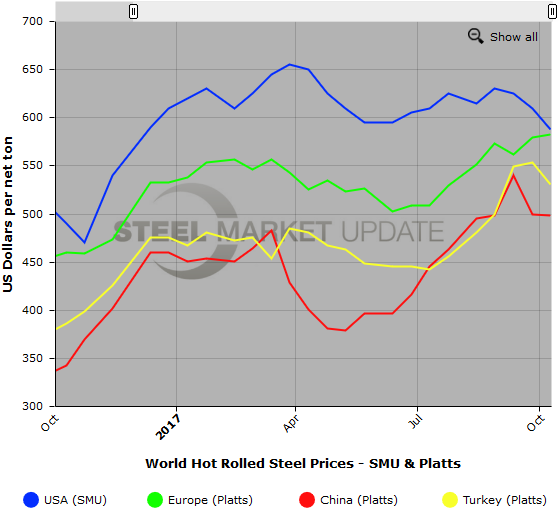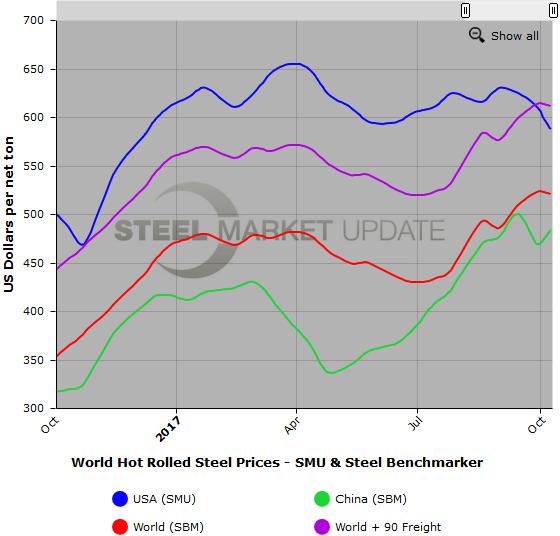International Steel Prices

Foreign vs. Domestic HR Price Comparison: Foreign Becoming Less Attractive
Written by Brett Linton
October 12, 2017
The following calculation is used by Steel Market Update to identify the theoretical spread between foreign hot rolled steel import prices (delivered to USA ports) and domestic (USA) hot rolled coil prices (FOB Domestic mills). We want our readers to be aware that this is only a “theoretical” calculation as freight costs, trader margin and other costs can fluctuate, ultimately influencing the true market spread.
Our primary numbers for this analysis are from Platts as we compare European HRC export pricing (FOB Ruhr), Turkey HRC export pricing (FOB Turkey) and Chinese HRC export pricing (FOB Chinese port). Be aware that Chinese hot rolled pricing is not available to the U.S. market, so the Chinese spread is nothing more than an exercise in “what if.” SteelBenchmarker is the secondary data provider of foreign hot rolled coil prices and is noted further down in this article.
![]() SMU adds $90 per ton to these foreign prices taking into consideration freight costs, handling, trader margin, etc. This provides an approximate “CIF U.S. ports price” that can then be compared against the SMU U.S. hot rolled price average (FOB Mill), with the result being the spread (difference) between domestic and foreign hot rolled prices. As the price spread narrows, the competitiveness of imported steel into the United States is reduced. If the spread widens, then foreign steel becomes more attractive to U.S. flat rolled steel buyers. A positive spread means U.S. prices are theoretically higher than foreign prices, while a negative spread means U.S. prices are less than foreign prices.
SMU adds $90 per ton to these foreign prices taking into consideration freight costs, handling, trader margin, etc. This provides an approximate “CIF U.S. ports price” that can then be compared against the SMU U.S. hot rolled price average (FOB Mill), with the result being the spread (difference) between domestic and foreign hot rolled prices. As the price spread narrows, the competitiveness of imported steel into the United States is reduced. If the spread widens, then foreign steel becomes more attractive to U.S. flat rolled steel buyers. A positive spread means U.S. prices are theoretically higher than foreign prices, while a negative spread means U.S. prices are less than foreign prices.
As of today (Thursday, Oct. 12), Platts published European HRC prices at $583 per net ton FOB Ruhr ($543 euros per metric ton), up $4 per ton from two weeks ago and up $21 from mid-September. Adding in $90 per ton for import costs, that puts the price at $673 per net ton from Europe delivered to the U.S. The latest Steel Market Update hot rolled price average is $588 per ton (rounded) for domestic steel, down $22 per ton from two weeks ago, and down $37 per ton over our mid-September price. This puts the theoretical spread between European and U.S. HR prices at -$85 per ton, down from a -$59 spread two weeks ago, and down from a -$27 spread one month ago. This means that U.S.-sourced HR is theoretically now $85 per ton cheaper than getting HR steel imported from Europe, and has been getting cheaper over the last few weeks.
Chinese HRC prices were reported by Platts as being $498 per net ton ($549 per metric ton), down $1 from two weeks ago, and down $42 from one month ago. Adding $90 in estimated import costs puts Chinese HRC prices at $588 per ton delivered (if Chinese mills were able to ship to the United States, which they are not). The theoretical spread between the Chinese and U.S. HR price is exactly $0 per ton, down from +$21 per ton two weeks ago, but up from -$5 per ton one month ago. Meaning that if Chinese mills were able to ship HR to the U.S., it would cost the same as buying steel produced domestically. With the exception of the mid-September spread, Chinese prices have been around $30 per ton cheaper than U.S. prices over the past few weeks.
Platts published Turkish export prices at $531 per net ton FOB Turkish port ($585 per metric ton), down $22 from two weeks ago and down $18 from one month ago. Adding $90 in import costs, the Turkish HRC “to the U.S. ports” price is $621 per ton. This puts the theoretical spread between the Turkish and U.S. HR price at -$33 per ton, unchanged from two weeks ago, and down from -$14 one month ago. This means that HR from the U.S. is theoretically $33 per ton cheaper than importing it from Turkey. There has been a shift over the past few weeks, as Turkish HR was previously $40-$80 cheaper than domestic steel over the summer months.
Below is a graph comparing Platts foreign HR export prices against the SMU domestic HR average price. You will need to view the graph on our website to use its interactive features; you can do so by clicking here. If you need assistance with either logging in or navigating the website, please contact us at 800-432-3475 or info@SteelMarketUpdate.com.
SteelBenchmarker World Export Price
The SteelBenchmarker world export price for hot rolled bands is $521 per net ton ($574 per metric ton) FOB the port of export, according to data released by SteelBenchmarker on Monday, Oct. 9. This is down $2 from the previous release on Sept. 25, but up $12 from one month ago. Adding in $90 in estimated import costs, that puts prices around $611 per ton delivered to the U.S. As previously mentioned, the latest Steel Market Update hot rolled price average is $588 per ton.
Therefore, the theoretical spread between the SteelBenchmarker world HR export price and the SMU HR price is -$23 per ton, meaning foreign HRC imported into the U.S. is theoretically now $23 per ton more expensive than steel purchased domestically. This spread is down from -$3 in mid-September, and down from +$26 one month ago.
This -$23 spread is around $50-70 lower than the average spread we have seen over the last few months. This is now the lowest price spread we have seen in 2017, surpassing the previous low we saw two weeks ago. This time last year, the spread was +$38 per ton, and was coming down from the record high in our seven-year recorded history, +$210 on June 27, 2016. Prior to 2016, the previous record high was a spread of +$94 in May 2014. The lowest spread in our history was -$70 in August 2011 (meaning domestic steel was theoretically $70 per ton cheaper than foreign steel). The average spread for 2017 YTD continues to move lower; it is now +$57 per ton.
We want to again remind our readers that the calculations shown above are “theoretical,” but in most markets are probably a good indicator of where you can expect to find offers being made.
Freight is an important part of the final determination on whether to import foreign steel or buy from a domestic mill supplier. Domestic prices are referenced as FOB the producing mill, while foreign prices are FOB the Port (Houston, NOLA, Savannah, Los Angeles, Camden, etc.). Inland freight, from either a domestic mill or from the port, can dramatically impact the competitiveness of both domestic and foreign steel.
Below is a graph comparing SteelBenchmarker world HR export prices against the SMU domestic HR average price. We also have included a line with the world price including freight and traders’ costs, which gives you a better indication of the true price spread. You will need to view the graph on our website to use its interactive features; you can do so by clicking here.

Brett Linton
Read more from Brett LintonLatest in International Steel Prices
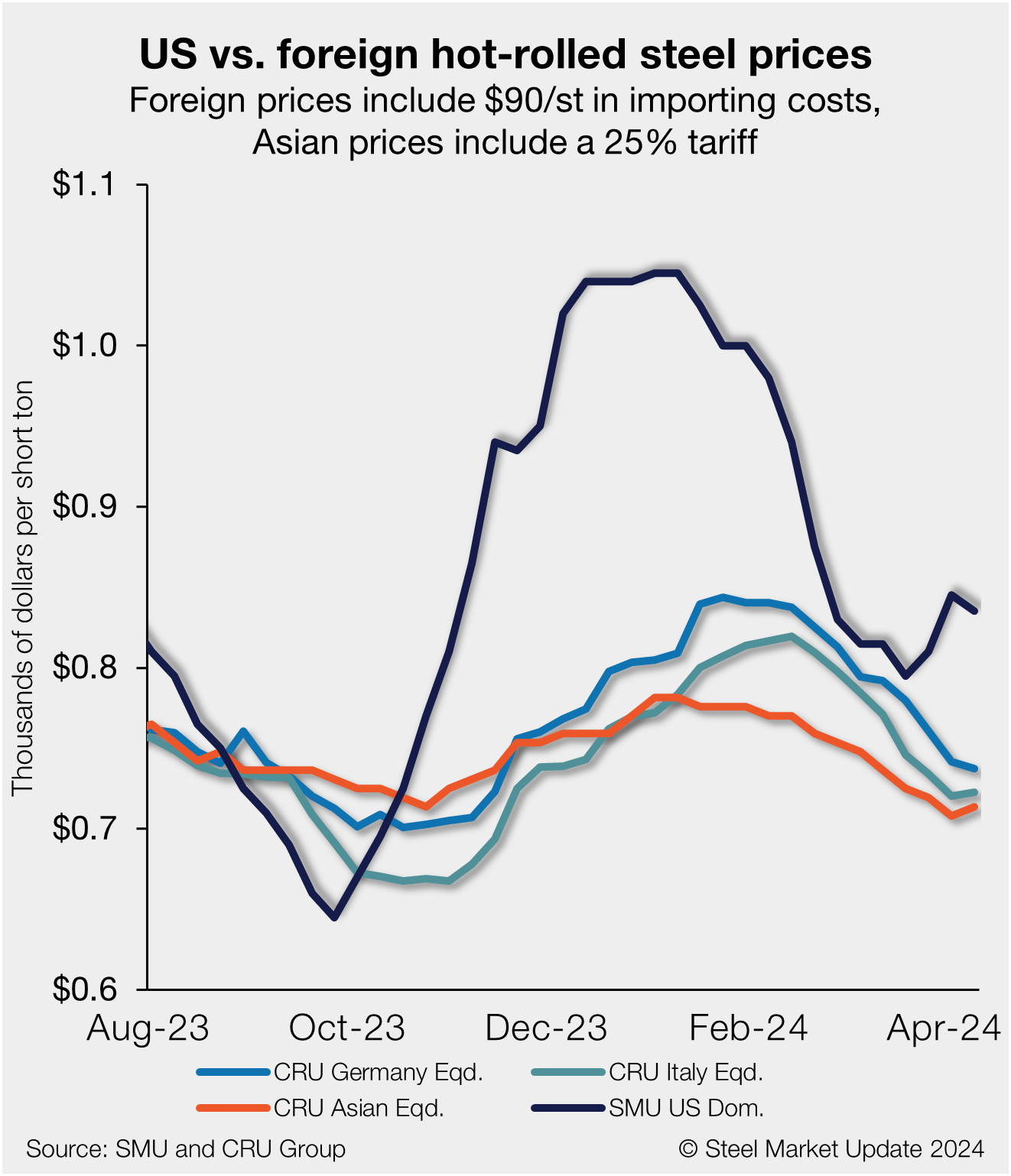
US HR prices slip, though still more expensive than imports
US hot-rolled (HR) coil has become increasingly more expensive than offshore hot band as stateside prices have moved higher at a sharper pace vs. imports.
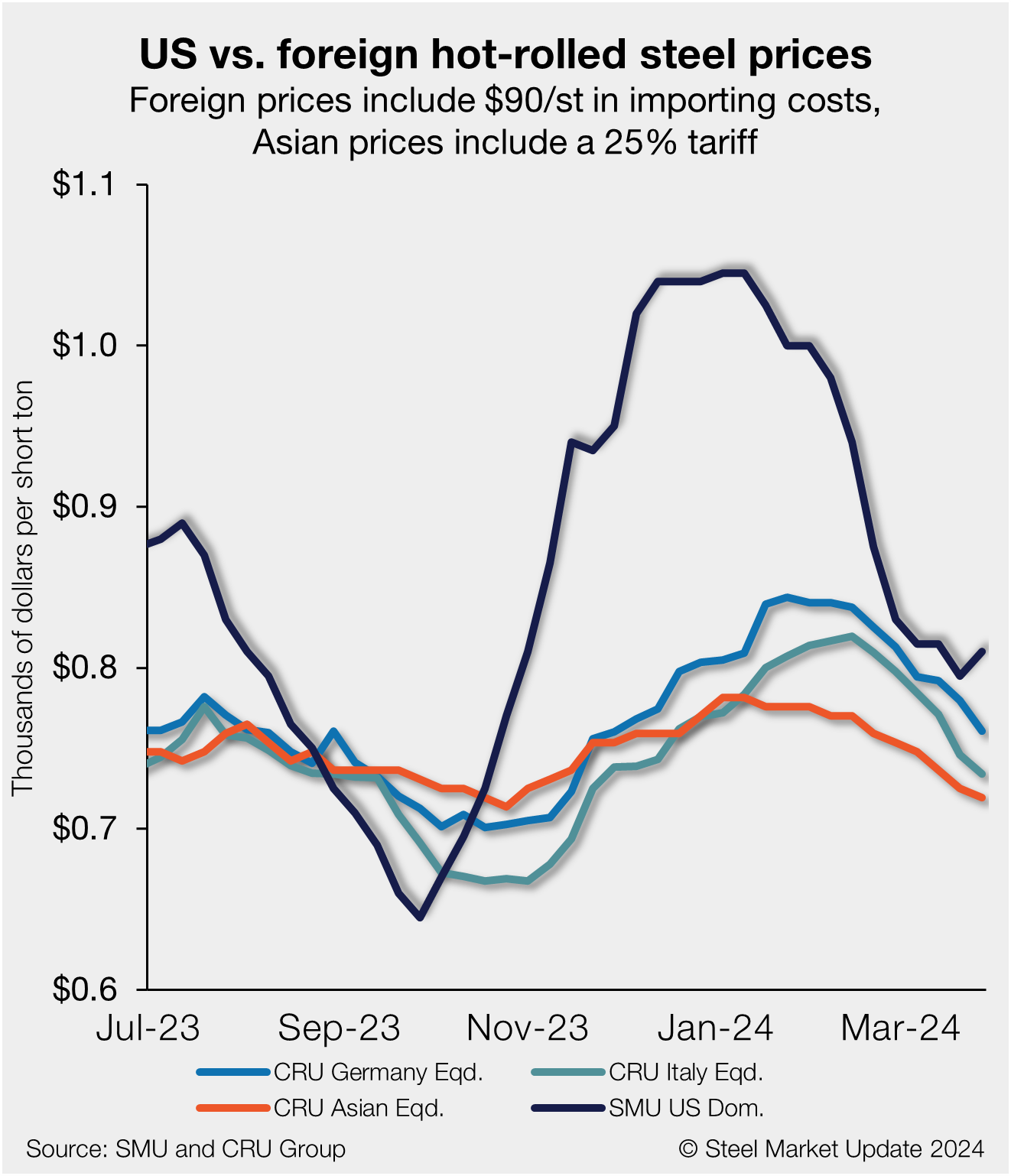
US HR prices rebound, no longer near parity with imports
US hot-rolled coil and offshore hot band moved further away from parity this week as stateside prices have begun to move higher in response to mill increases.
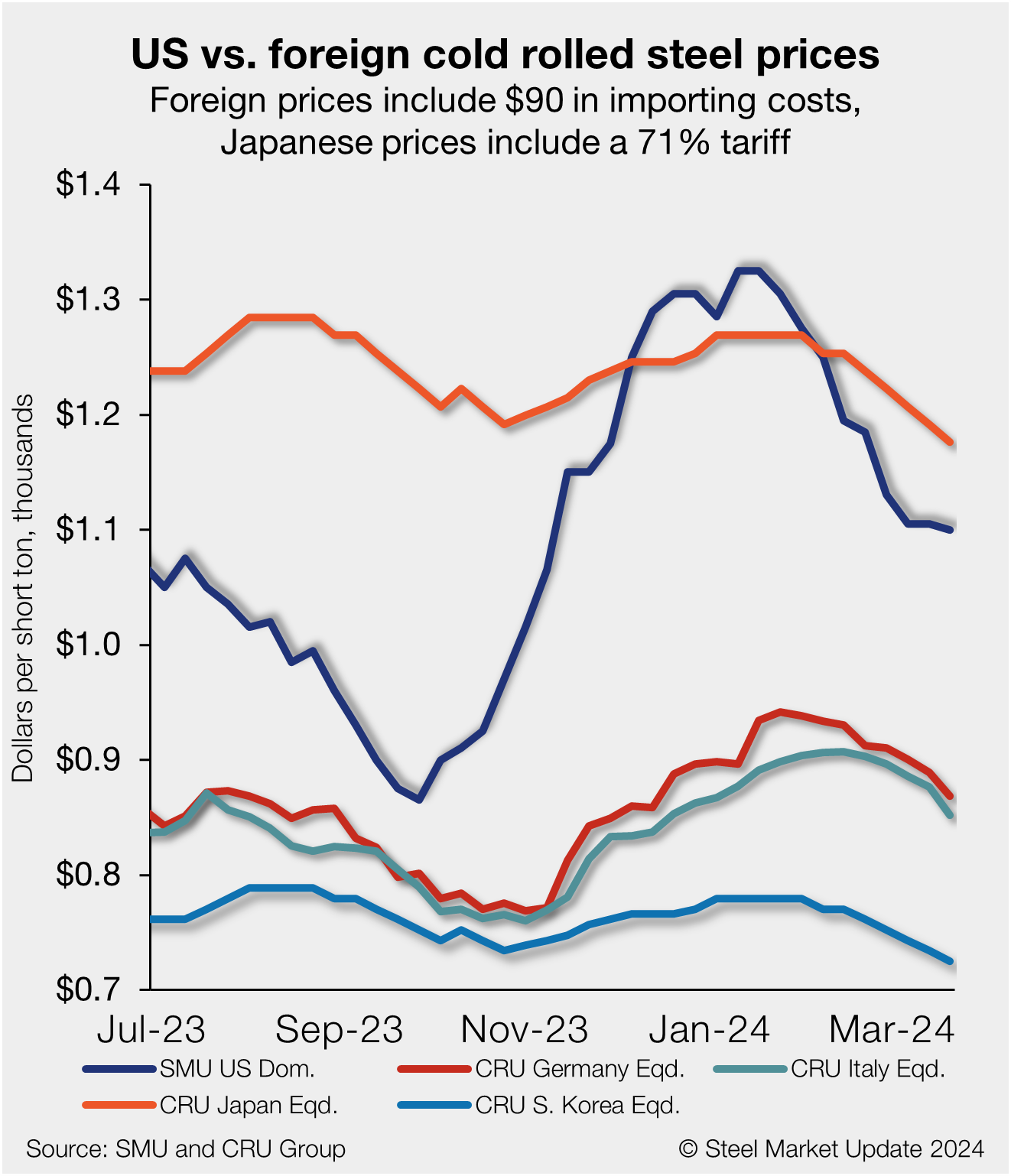
US cold rolled still more expensive than imports
Foreign cold-rolled (CR) coil remains notably less expensive than domestic product even with repeated tag declines across all regions, according to SMU’s latest check of the market.
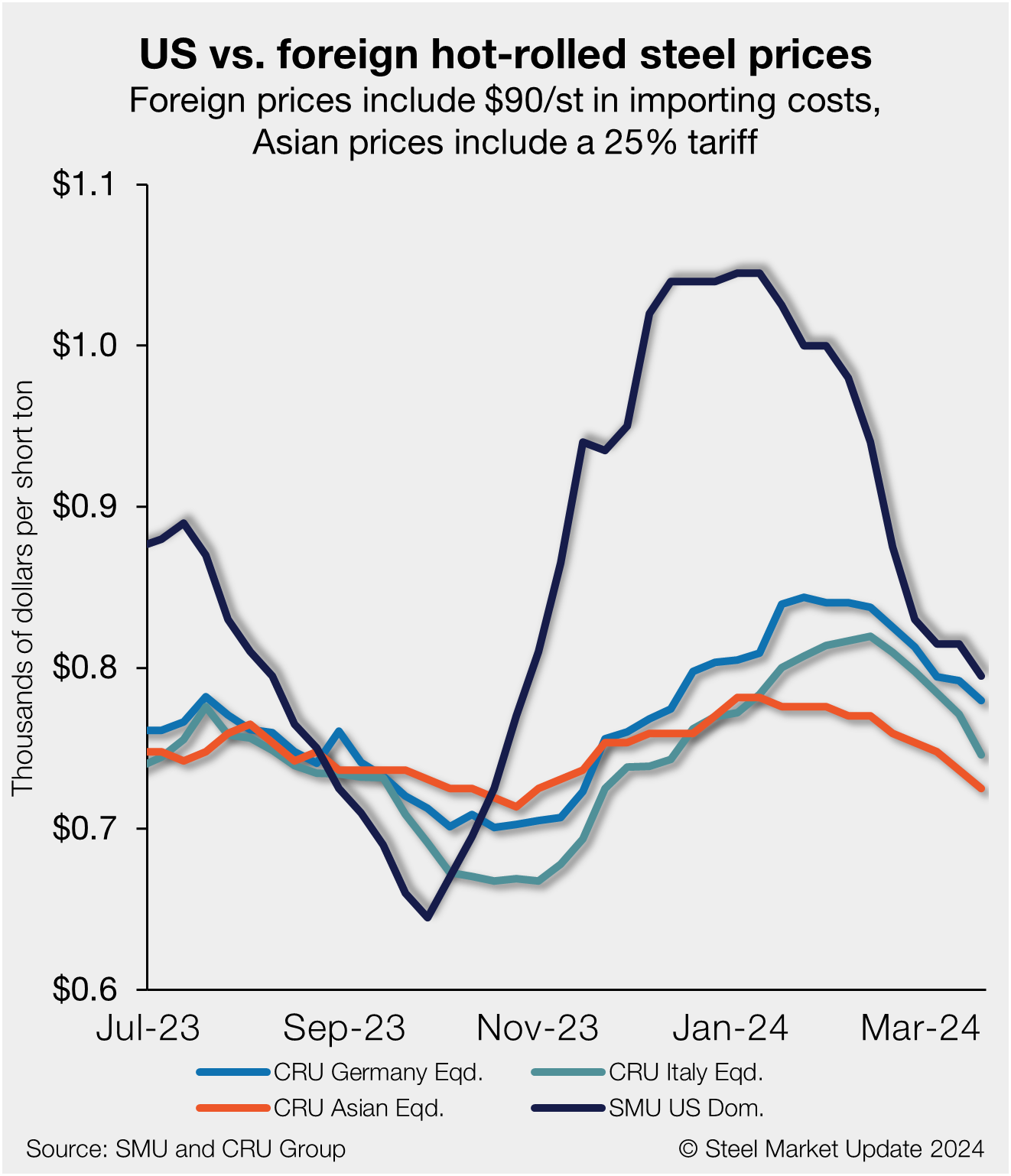
US HRC prices slowly inch toward parity with imports
US hot-rolled coil (HRC) remains more expensive than offshore hot band but continues to move closer to parity as prices decline further. The premium domestic product had over imports for roughly five months now remains near parity as tags abroad and stateside inch down.
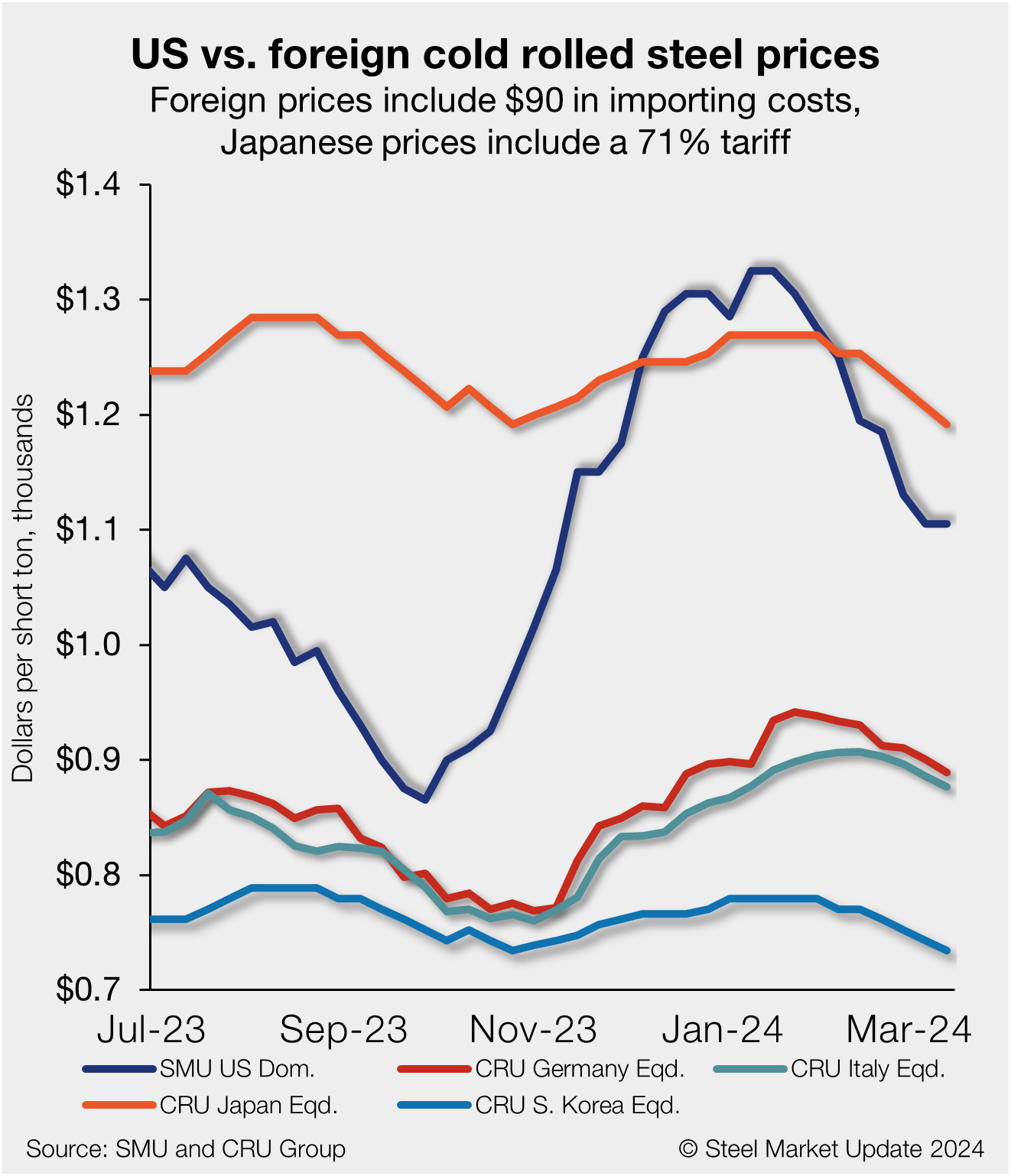
US cold rolled still more expensive than offshore product
Foreign cold-rolled coil (CR) remains significantly less expensive than domestic product even as US tags continue to decline in a hurry, according to SMU’s latest check of the market.

